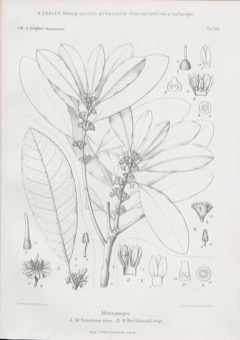 |
|
http://www.edibleplants.org |
 |
|
Translate this page:
Summary
Manilkara discolor, otherwise known as Red Milkweed or Silvery Milkwood, is an evergreen tree with a dense and round canopy and has many branches. It is grown in Kenya, Tanzania, Malawi Mozambique, Zimbabwe, and South Africa. It grows about 3 - 40 m in height. The trunk is smooth, light-colored, and straight. The leaves are large, oblong, and green with silvery hairs underneath. The flowers form into groups in leaf axils. The fruit has juicy and fleshy pulp that is delicious. It is yellow to red and round. The seed is flat, oval, and pale. The plant yields white latex. The wood is hard and used for fuel, or poles, tool handles, carvings, and spoons.
Physical Characteristics

 Manilkara discolor is an evergreen Tree growing to 20 m (65ft) by 20 m (65ft) at a medium rate.
Manilkara discolor is an evergreen Tree growing to 20 m (65ft) by 20 m (65ft) at a medium rate.
See above for USDA hardiness. It is hardy to UK zone 10. The flowers are pollinated by Bees.
Suitable for: light (sandy), medium (loamy) and heavy (clay) soils and prefers well-drained soil. Suitable pH: mildly acid, neutral and basic (mildly alkaline) soils. It can grow in semi-shade (light woodland) or no shade. It prefers dry or moist soil.
UK Hardiness Map
US Hardiness Map
Synonyms
Eichleria discolor (Sond.) M.M.Hartog Labourdonnaisia discolor Sond. Labourdonnaisia sericea Benth.
Plant Habitats
Edible Uses
Edible Parts: Fruit
Edible Uses:
Fruit - raw[398 ]. The juicy, fleshy pulp is very tasty[398 ]. Eaten as a snack, especially by children and travellers, the seeds are discarded[398 ]. The yellow to red, fleshy, oval berries are up to 13mm in diameter, enclosing an oval flattened pale-coloured seed[398 ].
References More on Edible Uses
Medicinal Uses
Plants For A Future can not take any responsibility for any adverse effects from the use of plants. Always seek advice from a professional before using a plant medicinally.
None known
References More on Medicinal Uses
The Bookshop: Edible Plant Books
Our Latest books on Perennial Plants For Food Forests and Permaculture Gardens in paperback or digital formats.

Edible Tropical Plants
Food Forest Plants for Hotter Conditions: 250+ Plants For Tropical Food Forests & Permaculture Gardens.
More

Edible Temperate Plants
Plants for Your Food Forest: 500 Plants for Temperate Food Forests & Permaculture Gardens.
More

More Books
PFAF have eight books available in paperback and digital formats. Browse the shop for more information.
Shop Now
Other Uses
Fuel Latex Wood
Agroforestry Uses: The tree is good for shade[398 ]. Other Uses The plant exudes a white latex[398 ]. The wood is hard[398 ]. It is used for poles, tool handles, carvings and spoons[398 ]. The wood is used for fuel[398 ].
Special Uses
Food Forest
References More on Other Uses
Cultivation details
Prefers a well-drained soil[308 ].
References Carbon Farming Information and Carbon Sequestration Information
Temperature Converter
Type a value in the Celsius field to convert the value to Fahrenheit:
Fahrenheit:
The PFAF Bookshop
Plants For A Future have a number of books available in paperback and digital form. Book titles include Edible Plants, Edible Perennials, Edible Trees,Edible Shrubs, Woodland Gardening, and Temperate Food Forest Plants. Our new book is Food Forest Plants For Hotter Conditions (Tropical and Sub-Tropical).
Shop Now
Plant Propagation
Seed -
Other Names
If available other names are mentioned here
Red milkwood, Silvery milkwood, Forest milkberry, Inheua, Manematfole, Masematfole, Mgama, Mgamba, Mghambo, Mkwichimbo, Muapo, Muraita, Nheu:a, Nhuebe, Nueve, Tineve, Tinguele, Umnweba, forest milkberry, bosmelkbessie.
Native Range
AFRICA: Kenya, KwaZulu-Natal, Malawi, Mozambique, Tanzania, Zimbabwe.
Weed Potential
Right plant wrong place. We are currently updating this section.
Please note that a plant may be invasive in one area but may not in your area so it's worth checking.
Conservation Status
IUCN Red List of Threatened Plants Status : This taxon has not yet been assessed

Growth: S = slow M = medium F = fast. Soil: L = light (sandy) M = medium H = heavy (clay). pH: A = acid N = neutral B = basic (alkaline). Shade: F = full shade S = semi-shade N = no shade. Moisture: D = dry M = Moist We = wet Wa = water.
Now available:
Food Forest Plants for Mediterranean Conditions
350+ Perennial Plants For Mediterranean and Drier Food Forests and Permaculture Gardens.
[Paperback and eBook]
This is the third in Plants For A Future's series of plant guides for food forests tailored to
specific climate zones. Following volumes on temperate and tropical ecosystems, this book focuses
on species suited to Mediterranean conditions—regions with hot, dry summers and cool, wet winters,
often facing the added challenge of climate change.
Read More
Expert comment
Author
(Sond.) J.H.Hemsl.
Botanical References
Links / References
For a list of references used on this page please go here
A special thanks to Ken Fern for some of the information used on this page.
Readers comment
| Add a comment |
|
If you have important information about this plant that may help other users please add a comment or link below. Only comments or links that are felt to be directly relevant to a plant will be included. If you think a comment/link or information contained on this page is inaccurate or misleading we would welcome your feedback at [email protected]. If you have questions about a plant please use the Forum on this website as we do not have the resources to answer questions ourselves.
* Please note: the comments by website users are not necessarily those held by PFAF and may give misleading or inaccurate information.
To leave a comment please Register or login here All comments need to be approved so will not appear immediately.
|
Subject : Manilkara discolor
|
|
|
|